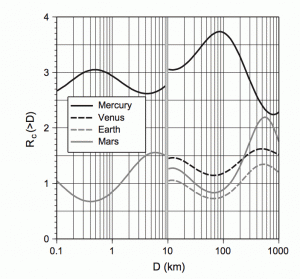Or — to pose this question more usefully — what’s the rate of crater-making impacts on Mars as compared to, say, the Moon?
Why the Moon? Because it’s the one extraterrestrial body for which scientists have both a long visible cratering record and rock samples from specific places with ages that can be dated in years. The only hitch in the scheme for Martians is that the Moon is smaller than Mars and farther from the asteroid belt, and thus some kind of scaling factor is needed to transfer lunar cratering rates to the Red Planet.

Scaling the rate (Rc) of Moon impacts to Mars (light gray line) shows that for craters less than about 100 kilometers in diameter, the rate is approximately the same for the Moon. Above that size, however, the Martian cratering rate, area for area, is roughly double the lunar rate. This graph also shows factors for Mercury, Venus, and Earth, however craters smaller than 10 kilometers' diameter are omitted for Earth and Venus because the different surface materials and atmospheric shielding effects skew the results. (Graph taken from the paper's figure 3.)
For years, scientists rolled together many kinds of data — sizes of asteroids, properties of target surfaces, asteroids vs. comets, and so on — to get a scaling factor of 3 to 5. That is, Mars should get hit about 3 to 5 times more often than the Moon.
A new paper by Mathieu Le Feuvre and Mark A. Wieczorek (Institut de Physique du Globe de Paris) published in the July 2011 issue of Icarus, explores in detail the question of the cratering rate on the Moon. The authors use an established model population of near-Earth objects coming from the asteroid belt to determine the frequency, size, and speed of impacts (and the resulting craters), and they then extend these results to the other terrestrial planets, including Mars.
What emerges from their calculations is that the old scaling factor for Mars now looks a little too large. The impact rate for Mars is about 3.2 times that of the Moon, but the Mars cratering rate is only 1.2 to 1.4 times that of the Moon, when averaged for all sizes of crater. The difference occurs because the Moon and Mars have different gravities, and impacting objects on average hit them at different velocities.
As the team writes, “Mars experiences a high impact rate with respect to the Moon (about 3) due to its proximity to the main asteroid belt. In comparison, the Martian cratering ratio is reduced (between about 0.5 and 2.5) because the impact velocity on Mars is significantly lower than on the Moon, requiring larger (and hence less numerous) impactors to create a crater of a given size.”








